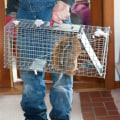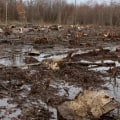Logging is the process of cutting down trees, an element of the logging task. The person who cuts down the trees is a feller. A feller buncher is a machine capable of cutting down a single large tree or grouping and cutting down several small ones simultaneously. The process of cutting a tree into usable lengths is called cutting.
Bulging often occurs as a tree is being cut, such as when the branches of the crown are to be used as firewood. When cutting firewood, it is important to know the length of wood needed before leaving home. When cutting full-size products, such as sawing logs and sheet metal logs, you need to cut logs longer than the final product to leave a trimming allowance. For an 8-foot log, a trimming margin of 4 to 6 inches is common.
Many cutting cuts are inclined, and the trimming allowance allows the ends of the boards to be cut squarely on the cutter to the desired board lengths.
Felling trees
in a forest is called deforestation. Deforestation occurs when a large number of trees are cut down with the intention of not replanting them. The felling of mature trees is called main use felling.In selective logging, some trees are cut down, while others are left standing. Selective logging may involve the felling of only large trees of good quality, and only the most valuable part of the trunk is used for wood. Another form of selective logging involves the cutting of large mature and immature trees of little value from time to time in forests with trees of various ages; all wood is used for timber. In Russia, selective logging was carried out in pine forests in the northern part of Europe and in some southern forests, where wood was purchased for shipbuilding.
In the USSR, selective logging is used to help a forest retain its protective properties. It is particularly recommended in tundra, water conservation and mountain forests. Directional felling is a specific tree cutting technique in which the operator determines the direction of fall before cutting. Wherever possible, trees should be cut down in the direction of existing canopy gaps to reduce damage to nearby standing wood.
In general, trees should be felled towards or away from the skating rinks, preferably at an oblique angle to the sliding direction. Felling away from the slide path will reduce problems for the extraction team when the treetops are large, while felling to the slide path can reduce the extraction distance substantially. When a tree is completely level, it is important to prevent the saw chain from falling into the ground. Removing attacked trees in time prevents damage from new generations of pests and, at the same time, preserves the value of wood by preventing further deterioration of wood by fungal agents or insects.
This and similar methods are often used in conjunction with sanitation methods and trap trees to destroy young and adult under-the-bark pests. If a tree has lodged or embedded itself in adjacent trees and has not fallen to the ground, it is important not to walk under it. If it needs to be removed and there is suspicion that logging will affect a power line, it is best to call the power company first. In this case, clear felling treatment is known as group selection harvest followed by immediate replanting. This and similar methods are often used in conjunction with sanitation methods and trap trees to destroy young and adult under-the-bark pests. If a tree has lodged or embedded itself in adjacent trees and has not fallen to the ground, it is important not to walk under it. If it needs to be removed and there is suspicion that logging will affect a power line, it is best to call the power company first. In this case, clear felling treatment is known as group selection harvest followed by immediate replanting.
A forest regeneration system that opens up canopy through small groups of felling (small crops) that create spaces where regeneration can occur is often referred to as group selection harvest practice. On plantations, many resources required by canopy mammals may be lacking or less abundant, including cavity trees, flowers, pollen, nectar, fruit and invertebrates (e.). Pole trees in middle canopy have smaller diameters, are easier to tilt and are spaced more often. In addition to category III trees and trees of undesirable species, some well-growing trees may be cut down to thin dense stands that are comparatively homogeneous.
Presented by Scandinavian logging specialists, this cut is easier to make, provides good guidance and has additional safety features. The 90 degree cut allows for extra room for a tree to fall before top and bottom undercut come together. Start at bottom of tree and work way up removing branches on opposite side as you go. Recent studies on western lowland gorillas indicate that they often climb trees for fruit but rest and travel on ground like other African apes.
For example, in two-storey stand of mature aspen (tall plant) and young spruce (understory), main use felling used in removal of aspen and maintenance felling in removal of spruce (to provide more light and weaken competition from roots). Tree regeneration compared in southern Rocky Mountains between paired and untreated harvested stands of thrush pine that had suffered more than 70% mortality due to D.



